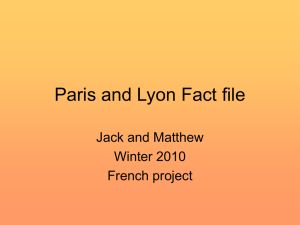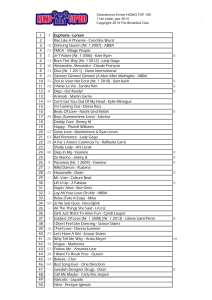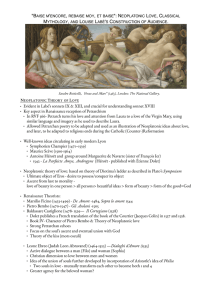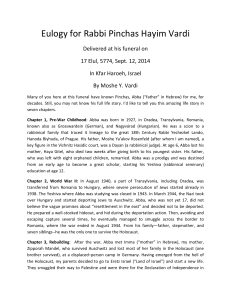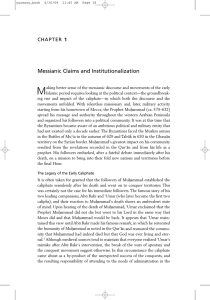L , P F
advertisement
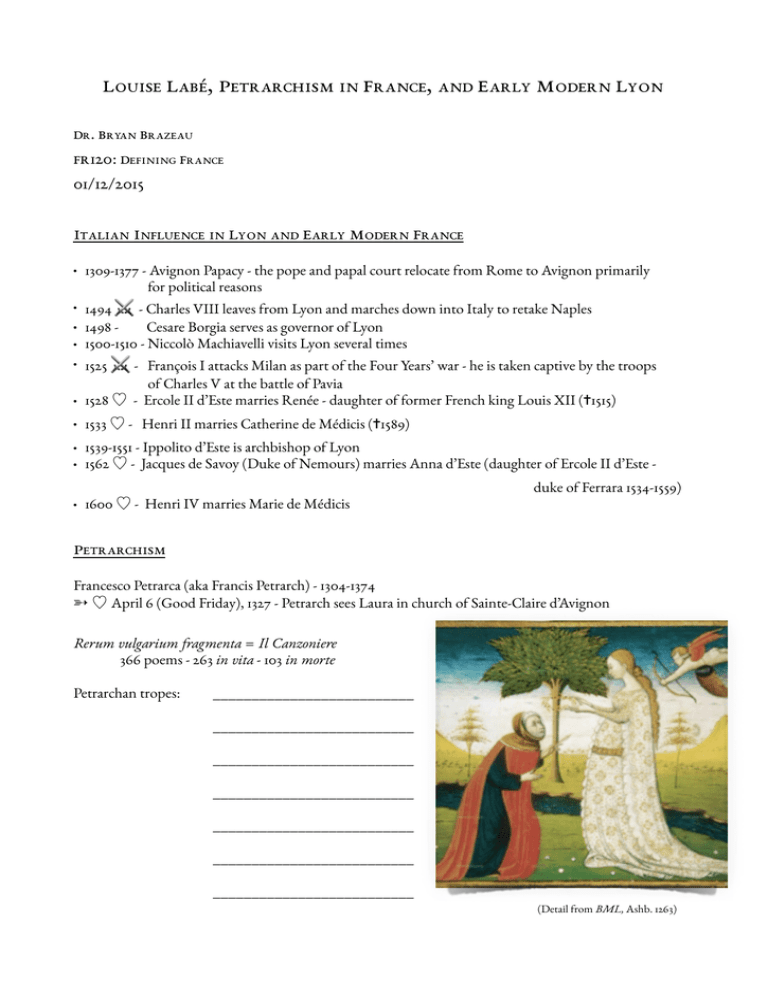
LOUISE LABÉ, PETRARCHISM IN FRANCE, AND EARLY MODERN LYON
DR. BRYAN BRAZEAU
FR120: DEFINING FRANCE
01/12/2015
ITALIAN INFLUENCE IN LYON AND EARLY MODERN FRANCE
• 1309-1377 - Avignon Papacy - the pope and papal court relocate from Rome to Avignon primarily
for political reasons
•
•
•
•
1494 ⚔ - Charles VIII leaves from Lyon and marches down into Italy to retake Naples
1498 Cesare Borgia serves as governor of Lyon
1500-1510 - Niccolò Machiavelli visits Lyon several times
1525 ⚔ - François I attacks Milan as part of the Four Years’ war - he is taken captive by the troops
of Charles V at the battle of Pavia
1528
♡
Ercole
II d’Este marries Renée - daughter of former French king Louis XII (✝1515)
•
• 1533 ♡ - Henri II marries Catherine de Médicis (✝1589)
• 1539-1551 - Ippolito d’Este is archbishop of Lyon
• 1562 ♡ - Jacques de Savoy (Duke of Nemours) marries Anna d’Este (daughter of Ercole II d’Este - • 1600 ♡ - Henri IV marries Marie de Médicis
duke of Ferrara 1534-1559)
PETRARCHISM
Francesco Petrarca (aka Francis Petrarch) - 1304-1374
➳ ♡ April 6 (Good Friday), 1327 - Petrarch sees Laura in church of Sainte-Claire d’Avignon
Rerum vulgarium fragmenta = Il Canzoniere
366 poems - 263 in vita - 103 in morte
Petrarchan tropes:
__________________________
__________________________
__________________________
__________________________
__________________________
__________________________
__________________________
(Detail from BML, Ashb. 1263)
Louise Labé: A Courtesan?
‘Loyse Labé, a Lyonnaise courtesan (also known as the beautiful ropemaker, as she was married to
a good man who made rope) could use spurs quite well on a horse, which is why the gentlemen
who frequented her called her ‘Captain Lois’, a woman, as it happens, who was of good and
bawdy spirits, and of mediocre beauty. She graciously received lords, gentlemen, and other
persons of merit in her home, entertaining them with debates and discussions, with music—at
which she was equally skilled with voice and instruments— readings of good Latin books along
with vernacular ones in Italian and Spanish which copiously ornamented her bookshelf, canapés
of exquisite jams and preserves, and finally, would privately share her most secret parts. In other
words, she shared her body with those who paid her. Nevertheless, she did not do so with all men,
and never with labourers or those of vile station, regardless of how much money they offered her.
She liked intelligent men above all, favouring them so much that those who knew her had the best
part of her favour. She preferred them to any great lord, and would rather show courtesy to the
former for free, than to the other for a great sum of écus—a practice which runs counter to the
custom of women of her trade and station. I do not give her a place in this library because she was
a courtesan, but only because she wrote the Débat de Folie et d’Amour - a dialogue in French
prose, three Élégies in verse, and twenty-four Sonnets, of which one was in Italian.
-La bibliotheque d'Antoine du Verdier, seigneur de Vauprivas (1584)
Use of Typefaces In Early Printing
ROMAN typefaces were often used for:
__________________________
Italic typefaces were often used for:
__________________________
What were the advantages of using Italic type? ______________________
Which modern font is based on a typeface used by Jean de Tournes? ________________
Labé’s Oeuvres (1555)
A)
B)
C)
D)
E)
F)
Dedicatory letter to noblewoman Clémence de Bourges
Débat de Folie et d’Amour
Élégies
24 Sonnets (4 per page) + 1 dedicated to poets who will praise her
24 Sonnets in praise of Labé by other poets (Greek, Latin, Italian, French)
Privilège du Roy - early form of copyright
Sonnet FormS
Volta - change/turn/shift in idea developed in the sonnet - underlined below
Italian-French :
Petrarchan:
Marotique (Italien):
Peletier (Français):
octave (8 lines = two quatrains) + sestet (6 lines)
abba abba {cde cde OR cd cd cd OR cdc dcd OR cde ced}
abba abba ccd eed
abba abba ccd ede
English (for comparison)
Spenserian:
Shakespearean:
abab bcbc cdcd ee
abab cdcd efef gg
